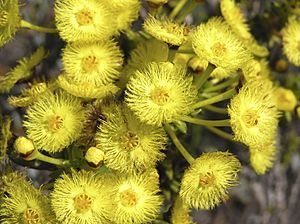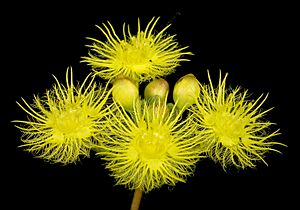Verticordia acerosa facts for kids
Quick facts for kids Verticordia acerosa |
|
|---|---|
 |
|
| Verticordia acerosa growing near Lake King | |
| Scientific classification | |
| Genus: |
Verticordia
|
| Species: |
acerosa
|
Verticordia acerosa is a beautiful flowering plant that belongs to the myrtle family, called Myrtaceae. This plant is special because it only grows in the south-west part of Western Australia. It's a type of shrub with yellow flowers that change color as they get older, turning red and then almost black.
There are two main types, or varieties, of Verticordia acerosa. They look a little different in their leaf shapes, flower colors, and some small parts inside the flower.
Contents
What Does This Plant Look Like?
Verticordia acerosa is a shrub that can grow up to about 1 meter (3 feet) tall. It has one main stem that branches out.
- The leaves lower down on the stem are long and thin, like a line. They are pointed and about 7 to 16 millimeters (0.3 to 0.6 inches) long. They might be slightly curved or almost round.
- The leaves closer to the flowers are shaped more like a spear or an egg, or even almost round.
The part that holds the flower, called the flower-cup, is shaped like a top. It's very small, about 1 to 1.5 millimeters (0.04 to 0.06 inches) long. It's smooth and has tiny bumps and 10 ridges. The petals of the flower look a bit like fingers and are about 3 to 4 millimeters (0.1 to 0.2 inches) long. They start out yellow and then turn red as they get older.
This plant usually blooms from August to November. In the southern parts of Western Australia, it starts flowering in September.
How Scientists Name This Plant
The first time this plant was officially described was in 1839 by a scientist named John Lindley. He wrote about it in a book called A Sketch of the Vegetation of the Swan River Colony.
The second part of its scientific name, acerosa, comes from a Latin word that means "full of chaff." This probably refers to the shape or texture of some part of the plant.
There are two main types, or varieties, of Verticordia acerosa:
- V. acerosa var. acerosa: This type has small parts inside the flower (called staminodes) that have a fringe of hairs. Its upper leaves are shaped like a spear or an egg, and its young flowers are bright yellow.
- V. acerosa var. preissii: This type has staminodes with jagged edges, and its upper leaves are oval or almost round. Its young flowers are a pretty lemon-yellow color.
Scientists like to group plants together based on how they are related. When a scientist named Alex George studied the Verticordia group in 1991, he placed Verticordia acerosa with other similar plants.
Where Does This Plant Live?
The acerosa variety of Verticordia acerosa likes to grow in certain types of soil called lateritic soils. You can find it in forests with Jarrah (a type of Eucalyptus tree) and Marri trees. It also grows in sandy areas in heathlands along the Darling Scarp (a long slope of hills) or at the bottom of these hills. You can see it between the towns of Forrestfield and Cannington.
The preissii variety is found in more places across the south-west of Western Australia, from Coorow all the way to the Fitzgerald River National Park. It can grow in many different kinds of soils and often lives alongside other Verticordia plants.
Is This Plant Safe?
Good news! The Government of Western Australia's Department of Parks and Wildlife says that Verticordia acerosa is "not threatened." This means it's not currently in danger of disappearing.
Growing This Plant in Gardens
People have been growing this beautiful Verticordia in gardens in England since 1842. You can grow new plants from cuttings (small pieces of the plant) or from seeds. Sometimes, the seeds even plant themselves!
This plant is great for gardens because it has:
- Nice leaves
- Red young stems
- Bright yellow, sweet-smelling flowers
The preissii variety often grows into a more striking and compact small shrub. It also tends to have larger groups of flowers than the other variety.
Both types of Verticordia acerosa need to be planted in light soils and a sunny spot. They can usually handle frost, but sometimes they might get sick from fungal infections.


